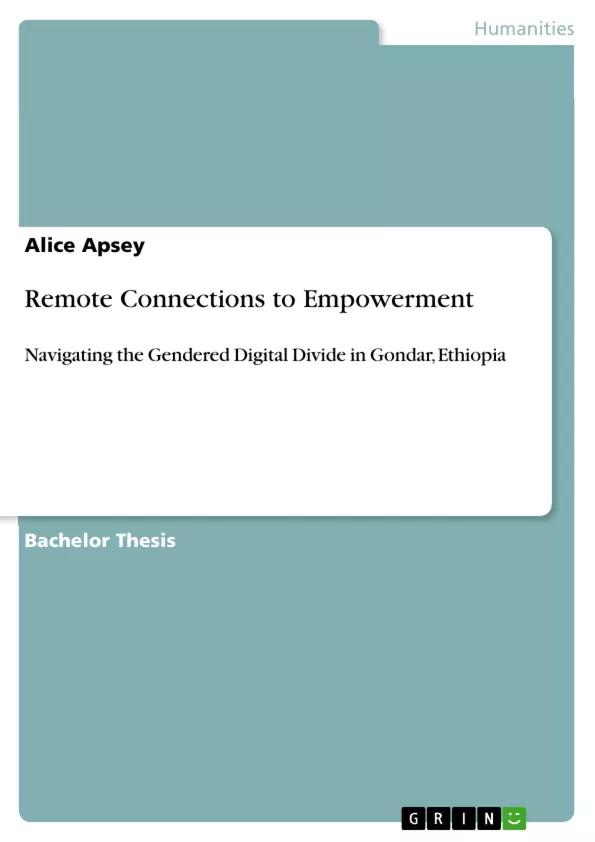Whilst the development of ICTs in Ethiopia has proved in many instances to be a promising tool for women's empowerment, a "complex web of factors" (Buskens & Webb, 2008) that determine access to these facilities has caused the scope of their benefit to be limited. In Ethiopia, engagements with ICTs in education and society continue to show a marked gender gap. To identify the obstacles to ICTs faced by women, the focus of analysis must extend beyond women themselves. Hence, this research has taken a multi-perspective approach, sampling a diverse range of respondents including men, women, youth, University students, IT professionals and government officials. This cross-section was taken from Gondar Town in the Amhara Region of Northern Ethiopia in order to situate the gendered barriers to ICT amongst a broader social, cultural, economic and political landscape. Therefore, since “ICT usage represents a social reality” (Wood, 2001: paragraph 5.7), “a gender lens alone becomes insufficient: other forms of social exclusions […] have to be considered” (Rowbotham, 1995:65, Morgan, Heeks & Arun, 2004).
Inhaltsverzeichnis (Table of Contents)
- Statement
- Acknowledgements
- Table of Figures
- Preface
- Abstract
- Acronyms
- Introduction
- Chapter One: Conceptual Field
- The ‘D’ in ICT4D: Tied to technological determinism and economic growth
- Gender in ICT4D: “Add women and stir”
- Diluted Empowerment
- Identifying and Bridging the gap in ICT4D
- Reconceptualising Empowerment in ICT4D: Incorporating choice and ‘jugaad’
- Chapter Two: Research Location
- Context of gender and ICT in Ethiopia
- Gondar
- Chapter Three: Methodologies
- Sampling: Representativeness and limitations of chain‐referral methods
- Ethnography: Reflexivity and practice
- Interviews and Focus Groups
- Researching the Youth: triangulating PRA methodologies
- Voicing the Silent Women
- Chapter Four: An Uneven Landscape of Access
- Telecommunications Infrastructure: A Monopoly Market
- Education in Gondar: Stretched Resources and Unequal Provision
- Urban‐Rural Digital Divide
- Chapter Five: The Gendered Digital Divide
- Cultural Constraints to ICT access: “The man, he controls the mouse”
- Heterogeneity of Women’s Experiences: Tsega and Tadila
- Chapter Six: Navigating the Digital Divide
Zielsetzung und Themenschwerpunkte (Objectives and Key Themes)
This research aims to investigate the differential engagements with and uses of ICTs by gender in Ethiopia, specifically focusing on the city of Gondar. The study aims to understand the main obstacles affecting ICT engagement, determine if women are disproportionately affected by the digital divide, and analyze how individuals negotiate these challenges.
- The role of technology in development, particularly the limitations of viewing ICTs as a "magic bullet" for social change.
- The impact of structural inequalities, such as political structures, education systems, and geographical location, on access to ICT.
- The influence of cultural norms and gender roles on women's engagement with ICTs.
- The diverse experiences of men and women in relation to ICT access and use.
- The concept of empowerment in ICT4D and its relationship to individual agency and structural factors.
Zusammenfassung der Kapitel (Chapter Summaries)
- Chapter One: Conceptual Field: This chapter outlines the theoretical framework for the research, examining the development goals of ICT4D, the role of gender in the ICT4D discourse, and the limitations of the concept of empowerment in ICT4D. It introduces Kleine's "choice framework," which considers individual agency and structural factors in relation to empowerment.
- Chapter Two: Research Location: This chapter provides context about the research location, Gondar, Ethiopia, highlighting the government's efforts to promote ICT development and gender equality. It also discusses the specific challenges faced by Gondar in terms of ICT access and gender inequalities.
- Chapter Three: Methodologies: This chapter details the research methods employed, including a chain‐referral sampling method for interviews, ethnographic participant observation through ICT classes, and participatory rural appraisal (PRA) techniques with students.
- Chapter Four: An Uneven Landscape of Access: This chapter analyzes the structural barriers that create an uneven landscape of ICT access in Gondar. It examines the monopoly market of ETC, the challenges faced by the education system, and the urban-rural digital divide.
- Chapter Five: The Gendered Digital Divide: This chapter examines the gendered barriers to ICT access in Gondar, highlighting the impact of cultural norms and perceptions of technology. It presents case studies of Tsega and Tadila to illustrate the diverse experiences of women with ICTs.
Schlüsselwörter (Keywords)
This research focuses on the complexities of the gendered digital divide in Gondar, Ethiopia. Key terms and concepts include ICT4D (ICTs for Development), empowerment, technological determinism, gender relations, structural inequalities, cultural norms, individual agency, choice framework, digital divide, and jugaad.
- Quote paper
- Alice Apsey (Author), 2014, Remote Connections to Empowerment, Munich, GRIN Verlag, https://www.hausarbeiten.de/document/281113


